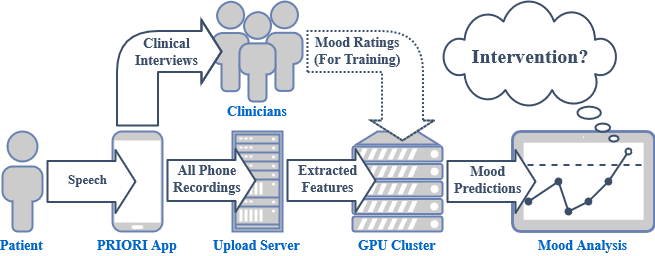
The Predicting Individual Outcomes for Rapid Intervention (PRIORI) project is entering a new phase! As with most research projects, The Prechter Program has learned that things are more complicated than initially thought. The initial strategy was based on what has been learned from people who live with bipolar disorder. Many times, family members say: “something is wrong—I can hear it in his/her voice.” Over the past several years, the Prechter Program has searched for patterns in speech that associate with mood states.
Several features of speech are associated with the mood of an individual when speech is sampled during mood assessments given by the research team. The challenge is finding a pattern over time that can be used to predict with reasonable accuracy whether a person is headed for an episode.
What happens when a close family member picks up on a cue from someone in difficulty? When asked, the family member often notes that it was the way the person responded to a particular theme in a discussion or argument — or the way they spoke when reflecting on a specific event. People with the bipolar condition have moods and emotions that can be unpredictable and reactive. In many cases, it is a stressful moment that triggers the expression of moods and emotions. Speech is the conduit.

The PRIORI program has learned that speech and expressions vary considerably, and the context of the interaction is important, if not critical. How one talks with a trusted loved one is often significantly different from a conversation with a repairman. What is going on in a person’s environment influences how someone reacts.
Over the past year PRIORI has made significant changes to gauge this critical context thanks to generous support by the Baszucki Brain Research Foundation. The PRIORI app has been adapted to sample the ambient audio around the person and process the features of the person’s speech.
This is in relation to the quality and character of the prevailing features of the audio/noise in the background. Processing is streamlined and only the relevant statistical measures are stored for further analysis. Rigorous security measures are in place and, as always, the program is only operating with the patient’s consent. The goal is to determine the minimal set of features, relevant to bipolar, that will serve as a measure of risk for an episode of mania or depression.
